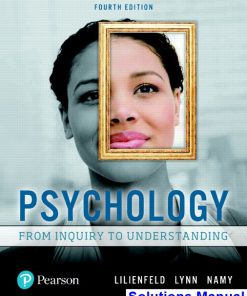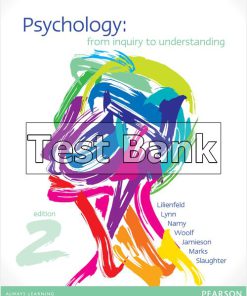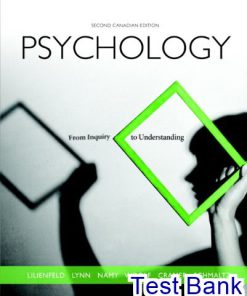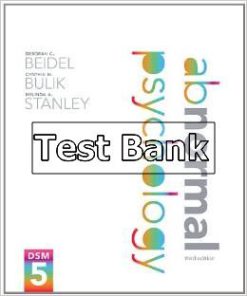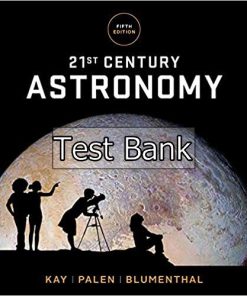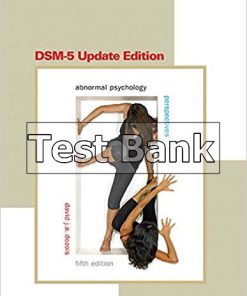Psychology From Inquiry to Understanding 4th Edition Lilienfeld Test Bank
$26.50$50.00 (-47%)
Psychology From Inquiry to Understanding 4th Edition Lilienfeld Test Bank.
You may also like
Psychology From Inquiry to Understanding 4th Edition Lilienfeld Test Bank

Product details:
- ISBN-10 : 0134552512
- ISBN-13 : 978-0134552514
- Author: Scott O. Lilienfeld
Provide the framework to go from inquiry to understanding
Psychology: From Inquiry to Understanding empowers students to apply scientific thinking to the psychology of their everyday lives. Authors Scott Lilienfeld, Steven Lynn, and Laura Namy introduce six principles of scientific thinking that serve as a clear framework for learning about psychology. As a result of this emphasis on the scientific method, the text helps students develop the critical thinking skills and open-minded skepticism needed to distinguish psychological misinformation from psychological information. In order to provide an up-to-date survey of the field, the Fourth Edition has been updated with the latest findings, coverage of fresh debates and challenges to psychology, and new sections on emerging areas of research.
Table contents:
- About Revel and the New Edition
- The Story of Revel—Why Revel?
- The Story of Revel—The Solution
- The Story of Revel—Your Students
- Support and Implementation—Getting Started with Revel
- Summary
- Chapter 1 Psychology and Scientific Thinking A Framework for Everyday Life
- Learning Objectives
- 1.1: What Is Psychology? Science Versus Intuition
- Psychology and Levels of Analysis
- What Makes Psychology Distinctive—and Fascinating
- Why We Can’t Always Trust Our Common Sense
- Naive Realism: is Seeing Believing?
- When Our Common Sense is Right
- Psychology as a Science
- What is A Scientific Theory?
- Science as A Safeguard Against Bias: Protecting Us From Ourselves
- Confirmation Bias
- Belief Perseverance
- Metaphysical Claims: The Boundaries of Science
- Recognizing That We Might Be Wrong
- 1.2: Psychological Pseudoscience: Imposters of Science
- The Amazing Growth of Popular Psychology
- What Is Pseudoscience?
- Warning Signs of Pseudoscience
- Overuse of ad hoc immunizing hypotheses
- Lack of self-correction
- Overreliance on anecdotes
- Why are We Drawn to Pseudoscience?
- Finding Comfort in Our Beliefs
- Thinking Clearly: An Antidote Against Pseudoscience
- Emotional Reasoning Fallacy
- Bandwagon Fallacy
- Not Me Fallacy
- The Dangers of Pseudoscience: Why Should We Care?
- 1.3: Scientific Thinking: Distinguishing Fact From Fiction
- Scientific Skepticism
- A Basic Framework for Scientific Thinking
- Scientific Thinking Principle #1: Ruling Out Rival Hypotheses
- Scientific Thinking Principle #2: Correlation Isn’t Causation
- Scientific Thinking Principle #3: Falsifiability
- Scientific Thinking Principle #4: Replicability
- Scientific Thinking Principle #5: Extraordinary Claims Require Extraordinary Evidence.
- Scientific Thinking Principle #6: Occam’s Razor
- 1.4: Psychology’s Past and Present: What a Long, Strange Trip it’s Been
- Psychology’s Early History
- The Great Theoretical Frameworks of Psychology
- Structuralism: The Elements of The Mind
- Functionalism: Psychology Meets Darwin
- Behaviorism: The Laws of Learning
- Cognitivism: Opening The Black Box
- Psychoanalysis: Plumbing The Depths of The Unconscious
- The Multifaceted World of Modern Psychology
- The Growth of A Field
- Types of Psychologists: Fiction and Fact
- The Great Debates of Psychology
- The Nature–Nurture Debate
- The Free Will–Determinism Debate
- How Psychology Affects Our Lives
- Applications of Psychological Research
- Thinking Scientifically: It’s A Way of Life.
- Summary: Psychology and Scientific Thinking
- 1.1: What Is Psychology? Science Versus Intuition
- 1.2: Psychological Pseudoscience: Imposters of Science
- 1.3: Scientific Thinking: Distinguishing Fact From Fiction
- 1.4: Psychology’s Past and Present: What a Long, Strange Trip It’s Been
- Chapter 2 Research Methods Vital Safeguards Against Error
- Learning Objectives
- 2.1: The Beauty and Necessity of Good Research Design
- Why We Need Research Designs
- How We Can Be Fooled: Two Modes of Thinking
- 2.2: Scientific Methodology: A Toolbox of Skills
- Naturalistic Observation: Studying Humans “In the Wild”
- Case Study Designs: Getting to Know You
- Self-Report Measures and Surveys: Asking People About Themselves and Others
- Random Selection: The Key to Generalizability
- Evaluating Measures
- Advantages and Disadvantages of Self-Report Measures
- Rating Data: How Do They Rate?
- Correlational Designs
- Identifying When A Design is Correlational
- Correlations: A Beginner’s Guide
- The Scatterplot
- Illusory Correlation
- Illusory Correlation and Superstition
- Why We Fall Prey to Illusory Correlation
- Correlation Versus Causation: Jumping the Gun
- Experimental Designs
- What Makes A Study an Experiment: Two Components
- Random Assignment
- Manipulation of an Independent Variable
- Confounds: Sources of False Conclusions
- Cause and Effect: Permission to Infer
- Pitfalls in Experimental Design
- The Placebo Effect
- The Nocebo Effect
- The Experimenter Expectancy Effect
- Demand Characteristics
- 2.3: Ethical Issues in Research Design
- Tuskegee: A Shameful Moral Tale
- Ethical Guidelines for Human Research
- Informed Consent
- Debriefing: Educating Participants
- Ethical Issues in Animal Research
- 2.4: Statistics: The Language of Psychological Research
- Descriptive Statistics: What’s What?
- Inferential Statistics: Testing Hypotheses
- Statistical Significance
- Practical Significance
- How People Lie With Statistics
- Example 1
- Question:
- Answer:
- Example 2
- Question:
- Answer:
- Example 3
- Question:
- Answer:
- The bottom line:
- 2.5: Evaluating Psychological Research
- Becoming a Peer Reviewer
- Study 1
- Question:
- Answer:
- Study 2
- Question:
- Answer:
- Most Reporters Aren’t Scientists: Evaluating Psychology in the Media
- Summary: Research Methods
- 2.1: The Beauty and Necessity of Good Research Design
- 2.2: Scientific Methodology: A Toolbox of Skills
- 2.3: Ethical Issues in Research Design
- 2.4: Statistics: The Language of Psychological Research
- 2.5: Evaluating Psychological Research
- Chapter 3 Biological Psychology Bridging the Levels of Analysis
- Learning Objectives
- 3.1: Nerve Cells: Communication Portals
- Neurons: The Brain’s Communicators
- The Cell Body
- Dendrites
- Axons and Axon Terminals
- Synapses
- Glial Cells
- Electrifying Thought
- Action Potentials
- The Absolute Refractory Period
- Chemical Communication: Neurotransmission
- Neurotransmitters
- Neurotransmitters and Psychoactive Drugs
- Neural Plasticity: How and When the Brain Changes
- Neural Plasticity Over Development
- Neural Plasticity and Learning
- Neural Plasticity Following Injury and Degeneration
- Adult Neurogenesis
- Stem Cells
- 3.2: The Brain–Behavior Network
- The Central Nervous System: The Command Center
- The Cerebral Cortex
- Frontal Lobes
- Parietal Lobe
- Temporal Lobe
- Occipital Lobe
- Cortical Hierarchies
- The Basal Ganglia
- The Limbic System
- The Cerebellum
- The Brain Stem
- Reticular Activating System
- The Pons and Medulla
- The Spinal Cord
- The Peripheral Nervous System
- The Somatic Nervous System
- The Autonomic Nervous System
- 3.3: The Endocrine System
- The Pituitary Gland and Pituitary Hormones
- The Adrenal Glands and Adrenaline
- Sexual Reproductive Glands and Sex Hormones
- 3.4: Mapping the Mind: The Brain in Action
- A Tour of Brain-Mapping Methods
- Phrenology: An Incorrect Map of the Mind
- Brain Damage: Understanding How the Brain Works by Seeing How it Doesn’t
- Electrical Stimulation and Recording of Nervous System Activity
- Brain Scans and Other Imaging Techniques
- CT Scans and MRI Images
- PET
- fMRI
- Magnetic Stimulation and Recording
- How to Interpret—and Misinterpret—Brain Scans
- How Much of Our Brain Do We Use?
- Which Parts of Our Brain Do We Use for What?
- Which Side of Our Brains Do We Use for What?
- 3.5: Nature and Nurture: Did Your Genes—or Parents—Make You Do It?
- How We Come to Be Who We Are
- The Biological Material of Heredity
- Genotype Versus Phenotype
- Behavioral Adaptation
- Human Brain Evolution
- Behavioral Genetics: How We Study Genetic and Environmental Influences on Behavior
- Heritability: Misconceptions and Conceptions
- Behavioral Genetic Designs
- Family Studies
- Twin Studies
- Adoption Studies
- Summary: Biological Psychology
- 3.1: Nerve Cells: Communication Portals
- 3.2: The Brain–Behavior Network
- 3.3: The Endocrine System
- 3.4: Mapping the Mind: The Brain in Action
- 3.5: Nature and Nurture: Did Your Genes—or Parents—Make You Do It?
- Chapter 4 Sensation and Perception How We Sense and Conceptualize the World
- Learning Objectives
- 4.1: Two Sides of the Coin: Sensation and Perception
- Sensation: Our Senses as Detectives
- Transduction: Going from the Outside World to Within
- Psychophysics: Measuring the Barely Detectable
- Absolute Threshold
- Just Noticeable Difference
- Signal Detection Theory
- Sensory Systems Stick to One Sense—Or Do They?
- The Role of Attention
- Selective Attention: How we Focus on Specific Inputs
- Inattentional Blindness
- The Binding Problem: Putting the Pieces Together
- 4.2: Seeing: The Visual System
- Light: The Energy of Life
- The Eye: How We Represent the Visual Realm
- How Light Enters the Eye
- The Sclera, Iris, and Pupil
- The Cornea, Lens, and Eye Muscles
- The Shape of the Eye
- The Retina: Changing Light into Neural Activity
- Rods and Cones
- The Optic Nerve
- How We Perceive Shape And Contour
- Feature Detection
- How we Perceive Color
- Trichromatic Theory
- Opponent Process Theory
- When We Can’t See or Perceive Visually
- Blindness
- Blindsight: How are Some Blind People Able to Navigate Their Worlds?
- Visual Agnosia
- 4.3: Hearing: The Auditory System
- Sound: Mechanical Vibration
- Pitch
- Loudness
- Timbre
- The Structure and Function of the Ear
- When We Can’t Hear
- 4.4: Smell and Taste: The Sensual Senses
- What Are Odors and Flavors?
- Sense Receptors for Smell and Taste
- Olfactory and Gustatory Perception
- When We Can’t Smell or Taste
- 4.5: Our Body Senses: Touch, Body Position, and Balance
- The Somatosensory System: Touch and Pain
- Pressure, Temperature, and Injury
- Specialized and Free Nerve Endings in the Skin
- How we Perceive Touch and Pain
- Phantom Limb Illusion
- When we Can’t Feel Pain
- Proprioception and Vestibular Sense: Body Position and Balance
- Proprioceptors: Telling the Inside Story
- The Vestibular Sense: A Balancing Act
- Ergonomics: Human Engineering
- 4.6: Perception: When Our Senses Meet Our Brains
- Parallel Processing: The Way Our Brain Multitasks
- Perceptual Hypotheses: Guessing What’s Out There
- Perceptual Sets
- Perceptual Constancy
- Gestalt Principles
- How we Perceive Faces
- How we Perceive Motion
- How We Perceive Depth
- Monocular Cues
- Binocular Cues
- Depth Perception Appears in Infancy
- How we Perceive Where Sounds are Located
- When Perception Deceives Us
- Subliminal and Extrasensory Perception
- Subliminal Perception and Persuasion
- Extrasensory Perception (ESP): Fact or Fiction?
- What’s Esp, Anyway?
- Is There Scientific Evidence for Esp?
- Why People Believe in ESP
- Psychic Predictions
- Summary: Sensation and Perception
- 4.1: Two Sides of the Coin: Sensation and Perception
- 4.2: Seeing: The Visual System
- 4.3: Hearing: The Auditory System
- 4.4: Smell and Taste: The Sensual Senses
- 4.5: Our Body Senses: Touch, Body Position, and Balance
- 4.6: Perception: When Our Senses Meet Our Brains
- Chapter 5 Consciousness Expanding the Boundaries of Psychological Inquiry
- Learning Objectives
- 5.1: The Biology of Sleep
- The Circadian Rhythm: The Cycle of Everyday Life
- Stages of Sleep
- Stage 1 Sleep
- Stage 2 Sleep
- Stages 3 and 4 Sleep
- Stage 5: Rem Sleep
- Lucid Dreaming
- Disorders of Sleep
- Insomnia
- Narcolepsy
- Sleep Apnea
- Night Terrors
- Sleepwalking and Sexsomnia
- 5.2: Dreams
- Freud’s Dream Protection Theory
- Activation–Synthesis Theory
- Dreaming and the Forebrain
- Neurocognitive Perspectives on Dreaming
- 5.3: Other Alterations of Consciousness and Unusual Experiences
- Hallucinations: Experiencing What Isn’t There
- Out-of-Body and Near-Death Experiences
- Mystical Experiences
- Hypnosis
- Myths and Facts about Hypnosis: What Hypnosis isn’t and What it is
- Theories of Hypnosis
- Sociocognitive Theory
- Dissociation Theory
- 5.4: Drugs and Consciousness
- Substance Use Disorders
- Diagnosis of Substance Use Disorder
- Explanations for Substance Use
- Sociocultural Influences
- Is There an Addictive Personality?
- Learning and Expectancies
- Genetic Influences
- Depressants
- Alcohol
- The Sedative-Hypnotics
- Stimulants
- Nicotine
- Cocaine
- Amphetamines
- Narcotics
- Psychedelics
- Marijuana
- LSD and Other Hallucinogens
- Summary: Consciousness
- 5.1: The Biology of Sleep
- 5.2: Dreams
- 5.3: Other Alterations of Consciousness and Unusual Experiences
- 5.4: Drugs and Consciousness
- Chapter 6 Learning How Nurture Changes Us
- Learning Objectives
- 6.1: Classical Conditioning
- Pavlov’s Discovery of Classical Conditioning
- Principles of Classical Conditioning
- Acquisition
- Extinction
- Spontaneous Recovery
- Stimulus Generalization
- Stimulus Discrimination
- Higher-Order Conditioning
- Applications of Classical Conditioning to Daily Life
- Classical Conditioning and Advertising
- The Acquisition of Fears and Phobias: The Strange Tale of Little Albert
- Fetishes
- Disgust Reactions
- 6.2: Operant Conditioning
- Distinguishing Operant Conditioning from Classical Conditioning
- The Law of Effect
- B. F. Skinner and Reinforcement
- Terminology of Operant Conditioning
- Reinforcement
- Punishment
- Discriminative Stimulus
- Same Song, Second Verse
- Extinction
- Stimulus Discrimination
- Stimulus Generalization
- Schedules of Reinforcement
- Applications of Operant Conditioning to Daily Life
- Animal Training
- Overcoming Procrastination: I’ll Get to that Later
- Therapeutic Applications of Operant Conditioning
- Putting Classical and Operant Conditioning Together
- 6.3: Cognitive Models of Learning
- S-O-R Psychology: Tossing Thinking Back into the Mix
- Latent Learning
- Observational Learning
- Observational Learning of Aggression
- Media Violence and Real-World Aggression
- Mirror Neurons and Observational Learning
- Insight Learning
- 6.4: Biological Influences on Learning
- Conditioned Taste Aversions
- Preparedness and Phobias
- Instinctive Drift
- 6.5: Learning Fads: Do They Work?
- Sleep-Assisted Learning
- Accelerated Learning
- Discovery Learning
- Learning Styles
- Summary: Learning
- 6.1: Classical Conditioning
- 6.2: Operant Conditioning
- 6.3: Cognitive Models of Learning
- 6.4: Biological Influences on Learning
- 6.5: Learning Fads: Do They Work?
- Chapter 7 Memory Constructing and Reconstructing Our Pasts
- Learning Objectives
- 7.1: How Memory Operates: The Memory Assembly Line
- The Paradox of Memory
- When Our Memories Serve us Well
- When Our Memories Fail us
- The Reconstructive Nature of Memory
- The Three Systems of Memory
- Sensory Memory
- Short-Term Memory
- The Duration of Short-Term Memory
- Memory Loss from Short-Term Memory: Decay versus Interference
- The Capacity of Short-Term Memory: The Magic Number
- Chunking
- Rehearsal
- Depth of Processing
- Long-Term Memory
- Differences Between Long-Term and Short-Term Memory
- Primacy and Recency Effects
- Types of Long-Term Memory
- 7.2: The Three Processes of Memory
- Encoding: The “Call Numbers” of the Mind
- The Role of Attention
- Mnemonics: Valuable Memory Aids
- Pegword Method
- Method of Loci
- Keyword Method
- Music
- Storage: Filing Away Our Memories
- The Value of Schemas
- Schemas and Memory Mistakes
- Retrieval: Heading for the “Stacks”
- Measuring Memory
- Recall and Recognition
- Relearning
- Tip-of-the-Tongue Phenomenon
- Encoding Specificity: Finding Things Where we Left Them
- Context-Dependent Learning
- State-Dependent Learning
- 7.3: The Biology of Memory
- The Neural Basis of Memory Storage
- The Elusive Engram
- Long-Term Potentiation—A Physiological Basis for Memory
- LTP and Glutamate
- Where Is Memory Stored?
- Amnesia—Biological Bases of Explicit and Implicit Memory
- Amnesia Fictions and Facts
- Case Studies of Amnesia: H. M. and Clive Wearing
- Emotional Memory
- The Role of the Amygdala
- Erasing Painful Memories
- The Biology of Memory Deterioration
- 7.4: The Development of Memory: Acquiring a Personal History
- Memory Over Time
- Infants’ Implicit Memory: Talking With Their Feet
- 7.5: False Memories: When Good Memory Goes Bad
- False Memories
- Flashbulb Memories
- Source Monitoring: Who Said That?
- Implanting False Memories in the Lab
- Misinformation Effect
- Lost in the Mall and Other Implanted Memories
- Event Plausibility
- Memories of Impossible or Implausible Events
- Generalizing from the Lab to the Real World
- Eyewitness Testimony
- The False Memory Controversy
- Learning Tips: Getting the Science of Memory to Work for Us
- Summary: Memory
- 7.1: How Memory Operates: The Memory Assembly Line
- 7.2: The Three Processes of Memory
- 7.3: The Biology of Memory
- 7.4: The Development of Memory: Acquiring a Personal History
- 7.5: False Memories: When Good Memory Goes Bad
- Chapter 8 Thinking, Reasoning, and Language Getting Inside Our Talking Heads
- Learning Objectives
- 8.1: Thinking and Reasoning
- Cognitive Economy—Imposing Order on Our World
- Heuristics and Biases: Double-Edged Swords
- Representativeness Heuristic
- Availability Heuristic
- Hindsight Bias
- Top-Down Processing
- Concepts and Schemas
- How does language influence our thoughts?
- 8.2: Thinking at Its Hardest: Decision-Making and Problem Solving
- Decision-Making: Choices, Choices, and More Choices
- Problem Solving: Accomplishing Our Goals
- Approaches to Solving Problems
- Obstacles to Problem Solving
- Salience of Surface Similarities
- Mental Sets
- Functional Fixedness
- Models of the Mind
- 8.3: How Does Language Work?
- The Features of Language
- Phonemes: The Ingredients
- Morphemes: The Menu Items
- Syntax: Putting The Meal Together
- Extralinguistic Information: The Overall Dining Experience
- Language Dialects: Regional and Cultural Differences In Dining Habits
- How and Why Did Language Come About?
- How Do Children Learn Language?
- Perceiving and Producing The Sounds of Language
- Learning Words
- Syntactic Development: Putting It All Together
- Bilingualism
- Critical Periods for Language Learning
- Theoretical Accounts of Language Acquisition
- The “Pure” Nature and Nurture Accounts
- The Social Pragmatics Account
- The General Cognitive Processing Account
- Nonhuman Animal Communication
- How Animals Communicate
- Teaching Human Language to Nonhuman Animals
- 8.4: Written Communication: Connecting Language and Reading
- Reading: Learning to Recognize the Written Word
- Does Speed-Reading Work?
- Summary: Thinking, Reasoning, and Language
- 8.1: Thinking and Reasoning
- 8.2: Thinking at Its Hardest: Decision-Making and Problem Solving
- 8.3: How Does Language Work?
- 8.4: Written Communication: Connecting Language and Reading
- Chapter 9 Intelligence and IQ Testing Controversy and Consensus
- Learning Objectives
- 9.1: What Is Intelligence? Definitional Confusion
- Intelligence as Sensory Capacity: Out of Sight, Out of Mind
- Intelligence as Abstract Thinking
- Intelligence as General versus Specific Abilities
- Fluid and Crystallized Intelligence
- Multiple Intelligences: Different Ways of Being Smart
- Frames of Mind
- The Triarchic Model
- Biological Bases of Intelligence
- Intelligence and Brain Structure and Function
- The Location of Intelligence
- Intelligence and Reaction Time
- Intelligence and Memory
- Pulling it all Together
- 9.2: Intelligence Testing: The Good, the Bad, and the Ugly
- How We Calculate IQ
- The Eugenics Movement: Misuses and Abuses of IQ Testing
- IQ Testing Today
- Commonly Used Adult IQ Tests
- Commonly Used Childhood IQ Tests
- Culture-Fair IQ Tests
- College Admissions Tests: What Do They Measure?
- College Admissions Tests and IQ
- Coaching on College Admissions Tests
- Reliability of IQ Scores: Is IQ Forever?
- Stability of IQ in Adulthood
- Stability of IQ in Infancy and Childhood
- Validity of IQ Scores: Predicting Life Outcomes
- A Tale of Two Tails: From Intellectual Disability to Genius
- Intellectual Disability
- Genius and Exceptional Intelligence
- 9.3: Genetic and Environmental Influences on IQ
- Exploring Genetic Influences on IQ
- Family Studies
- Twin Studies
- Adoption Studies
- Exploring Environmental Influences on IQ
- Does How we Think About Intelligence Affect IQ?
- Birth Order: Are Older Siblings Wiser?
- Does Schooling Make us Smarter?
- Boosting IQ by Early Intervention
- A Self-Fulfilling Prophecy: Expectancy Effects on IQ
- Poverty and IQ: Socioeconomic and Nutritional Deprivation
- Getting Smarter all the Time: The Mysterious Flynn Effect
- 9.4: Group Differences in IQ: The Science and the Politics
- Sex Differences in IQ and Mental Abilities
- Sex Differences in IQ
- Sex Differences in Specific Mental Abilities
- Potential Causes of Sex Differences
- Racial Differences in IQ
- For Whom the Bell Curve Tolls
- Reconciling Racial Differences
- What are the Causes of Racial Differences in IQ?
- Test Bias
- Stereotype Threat
- 9.5: The Rest of the Story: Other Dimensions of Intellect
- Creativity
- Interests and Intellect
- Emotional Intelligence: Is EQ as Important as IQ?
- Curiosity and Grit
- Wisdom
- Summary: Intelligence and IQ Testing
- 9.1: What Is Intelligence? Definitional Confusion
- 9.2: Intelligence Testing: The Good, the Bad, and the Ugly
- 9.3: Genetic and Environmental Influences on IQ
- 9.4: Group Differences in IQ: The Science and the Politics
- 9.5: The Rest of the Story: Other Dimensions of Intellect
- Chapter 10 Human Development How and Why We Change
- Learning Objectives
- 10.1: Special Considerations in Human Development
- Clarifying the Nature–Nurture Debate
- Gene–Environment Interaction
- Nature Via Nurture
- Gene Expression
- The Mystique of Early Experience
- Keeping an Eye on Cohort Effects
- Post Hoc Fallacy
- Bidirectional Influences
- 10.2: The Developing Body: Physical and Motor Development
- Conception and Prenatal Development: From Zygote to Baby
- Brain Development: 18 Days and Beyond
- Obstacles to Normal Fetal Development
- Premature Birth
- Low Birth Weight
- Hazardous Environmental Influences
- Genetic Disorders
- Infant Motor Development: How Babies Get Going
- Survival Instincts: Infant Reflexes
- Learning to Get Up and Go: Coordinating Movement
- Factors Influencing Motor Development
- Growth and Physical Development Throughout Childhood
- Physical Maturation in Adolescence: The Power of Puberty
- Physical Development in Adulthood
- Physical Changes in Middle Adulthood
- Changes in Agility and Physical Coordination With Age
- 10.3: The Developing Mind: Cognitive Development
- Theories of Cognitive Development
- Piaget’s Theory: How Children Construct Their Worlds
- Assimilation and Accommodation
- Pros and Cons of Piaget’s Theory
- Vygotsky’s Theory: Social and Cultural Influences on Learning
- Contemporary Theories of Cognitive Development
- General Cognitive Accounts
- Sociocultural Accounts
- Modular Accounts
- Cognitive Landmarks of Early Development
- Physical Reasoning: Figuring Out Which Way is Up
- Concepts and Categories: Classifying the World
- Self-Concept and the Concept of “Other”: Who We Are and Who We Aren’t
- Numbers and Mathematics: What Counts
- Cognitive Changes in Adolescence
- Attitudes Toward Knowledge in Adolescents and Young Adults
- Cognitive Function in Adulthood
- 10.4: The Developing Personality: Social and Moral Development
- Social Development in Infancy and Childhood
- Temperament and Social Development: Babies’ Emotional Styles
- Attachment: Establishing Bonds
- Imprinting
- Contact Comfort: The Healing Touch
- Attachment Styles: The Strange Situation
- Influence of Parenting on Development
- Parenting Styles and Later Adjustment
- Peers Versus Parents
- The Role of the Father
- “Nontraditional” Families: Science and Politics
- Effects of Divorce on Children
- Self-Control: Learning to Inhibit Impulses
- The Development of Gender Identity
- Transgender experience: When biological sex and gender identity collide
- Development of gender concepts
- Social and Emotional Development in Adolescence
- Building An Identity
- Erikson’s Model of Identity: The Identity Crisis
- Emerging Adulthood
- Moral Development: Knowing Right From Wrong
- Children’s Moral Development
- Kohlberg and Morality: Finding the Moral High Ground
- Criticisms of Kohlberg’s Work
- Life Transitions in Adulthood
- Careers
- Love and Commitment
- Parenthood
- Midlife Transitions
- Social Transitions in Later Years
- Summary: Human Development
- 10.1: Special Considerations in Human Development
- 10.2: The Developing Body: Physical and Motor Development
- 10.3: The Developing Mind: Cognitive Development
- 10.4: The Developing Personality: Social and Moral Development
- Chapter 11 Emotion and Motivation What Moves Us
- Learning Objectives
- 11.1: Theories of Emotion: What Causes Our Feelings?
- Discrete Emotions Theory: Emotions as Evolved Expressions
- Support for an Evolutionary Basis of Emotions
- Culture and Emotion
- Recognition of Emotions Across Cultures
- Cultural Differences in Emotional Expression: Display Rules
- Accompaniments of Emotional Expressions
- Emotions and Physiology
- Real Versus Fake Emotions
- Cognitive Theories of Emotion: Think First, Feel Later
- James–Lange Theory of Emotion
- Cannon–Bard Theory of Emotion
- Two-Factor Theory of Emotion
- Putting it All Together
- Unconscious Influences on Emotion
- Automatic Generation of Emotion
- Mere Exposure Effect
- Facial Feedback Hypothesis
- 11.2: Nonverbal Expression of Emotion: The Eyes, Bodies, and Cultures Have It
- The Importance of Nonverbal Cues
- Body Language and Gestures
- Personal Space
- Lying and Lie Detection
- Humans as Lie Detectors
- The Polygraph Test
- Evaluating the Polygraph Test: What’s the Truth?
- Other Methods of Lie Detection
- Guilty Knowledge Test
- Tests Using Brain-Scanning Techniques
- Truth Serum
- Integrity Tests
- 11.3: Happiness and Self-Esteem: Science Confronts Pop Psychology
- What Happiness Is Good For
- What Makes Us Happy: Myths and Realities
- Forecasting Happiness
- Self-Esteem: Important or Overhyped?
- The Myths of Self-Esteem
- Narcissism: It’s All About Me
- The Potential Benefits of Self-Esteem
- Positive Psychology: Psychology’s Future or Psychology’s Fad?
- 11.4: Motivation: Our Wants and Needs
- Motivation: A Beginner’s Guide
- Drive Reduction Theory
- Drives and Arousal: Not Getting Ahead of the Curve
- When Our Drives Clash: Approach and Avoidance
- Incentive Theories
- Our Needs: Physical and Psychological Urges
- Hunger, Eating, and Eating Disorders
- Hunger and Eating: Regulatory Processes
- Weight Gain and Obesity: Biological and Psychological Influences
- Chemical Messengers and Eating
- The Set Point
- The Role of Genes in Obesity
- Sensitivity to Cues and Expectations
- A Surgical Option for Significant Weight Loss: Bariatric Surgery
- Eating Disorders: Bulimia and Anorexia
- Sexual Motivation
- Sexual Desire and its Causes
- The Physiology of the Human Sexual Response
- Frequency of Sexual Activities and Aging
- Sexuality and Culture
- Sexual Orientation: Science and Politics
- Prevalence of Different Sexual Orientations
- Can Sexual Orientation Be Changed?
- Genetic and Environmental Influences on Sexual Orientation
- Sex Hormones, Prenatal Influences, and Sexual Orientation
- Sexual Orientation: Brain Differences
- 11.5: Attraction, Love, and Hate: The Greatest Mysteries of Them All
- Social Influences on Interpersonal Attraction
- Proximity: When Near Becomes Dear
- Similarity: Like Attracts Like
- Reciprocity: All Give and No Take does Not A Good Relationship Make
- Physical Attraction: Like it or Not, we Judge Books by Their Covers
- Sex Differences in What we Find Attractive: Nature, Nurture, or Both?
- Evolutionary Models of Attraction
- Social Role Theory
- Is Beauty in the Eye of the Beholder?
- When Being “Just Average” is Just Fine
- Love: Science Confronts the Mysterious
- Passionate Love: Love as a Hollywood Romance
- Companionate Love: Love as Friendship
- The Three Sides of Love
- Hate: A Neglected Topic
- Summary: Emotion and Motivation
- 11.1: Theories of Emotion: What Causes Our Feelings?
- 11.2: Nonverbal Expression of Emotion: The Eyes, Bodies, and Cultures Have It
- 11.3: Happiness and Self-Esteem: Science Confronts Pop Psychology
- 11.4: Motivation: Our Wants and Needs
- 11.5: Attraction, Love, and Hate: The Greatest Mysteries of Them All
- Chapter 12 Stress, Coping, and Health The Mind–Body Interconnection
- Learning Objectives
- 12.1: What Is Stress?
- Stress in the Eye of the Beholder: Three Approaches
- Stressors as Stimuli
- Stress as A Response
- Stress as A Transaction
- No Two Stresses Are Created Equal: Measuring Stress
- Major Life Events
- Hassles: Don’t Sweat the Small Stuff
- 12.2: How We Adapt to Stress: Change and Challenge
- The Mechanics of Stress: Selye’s General Adaptation Syndrome
- The Alarm Reaction
- Resistance
- Exhaustion
- The Diversity of Stress Responses
- Fight or Flight or Tend and Befriend?
- Long-Lasting Stress Reactions
- 12.3: Coping With Stress
- Social Support
- Gaining Control
- Behavioral Control
- Cognitive Control
- Decisional Control
- Informational Control
- Emotional Control
- Is Catharsis A Good Thing?
- Does Crisis Debriefing Help?
- Individual Differences in Coping: Attitudes, Beliefs, and Personality
- Hardiness: Challenge, Commitment, and Control
- Optimism
- Spirituality and Religious Involvement
- Flexible Coping
- Rumination: Recycling the Mental Garbage
- 12.4: How Stress Impacts Our Health
- The Immune System
- Psychoneuroimmunology: Our Bodies, Our Environments, and Our Health
- Stress and Colds
- Stress and Immune Function: Beyond the Common Cold
- Stress-Related Illnesses: A Biopsychosocial View
- Coronary Heart Disease
- The Role of Stress in CHD
- The Role of Personality in CHD
- CHD, Everyday Experiences, and Socioeconomic Factors
- 12.5: Promoting Good Health— and Less Stress!
- Toward a Healthy Lifestyle
- Healthy Behavior #1: Stop Smoking
- Healthy Behavior #2: Curb Alcohol Consumption
- Healthy Behavior #3: Achieve A Healthy Weight
- Tips for Achieving a Healthy Weight
- Healthy Behavior #4: Exercise
- But Changing Lifestyles is Easier Said Than Done
- Personal Inertia
- Misestimating Risk
- Feeling Powerless
- Prevention Programs
- Complementary and Alternative Medicine
- Biologically Based Therapies: Vitamins, Herbs, and Food Supplements
- Manipulative and Body-Based Methods: The Example of Chiropractic Medicine
- Mind-Body Medicine: Biofeedback, Meditation, and Yoga
- Energy Medicine: The Case of Acupuncture
- Whole Medical Systems: The Example of Homeopathy
- Placebos and CAM
- Cam Treatments: To Use or Not to Use, That is the Question
- Summary: Stress, Coping, And Health
- 12.1: What Is Stress?
- 12.2: How We Adapt to Stress: Change and Challenge
- 12.3: Coping With Stress
- 12.4: How Stress Impacts Our Health
- 12.5: Promoting Good Health—and Less Stress!
- Chapter 13 Social Psychology How Others Affect Us
- Learning objectives
- 13.1: What Is Social Psychology?
- Humans as a Social Species
- Gravitating to Each Other—To a Point
- The Need to Belong: Why we Form Groups
- How we Came to be this Way: Evolution and Social Behavior
- Social Comparison: Where do I Stand?
- Social Contagion
- Mass Hysteria: Irrationality at a Group Level
- Urban Legends
- Social Facilitation: From Bicyclists to Cockroaches
- The Fundamental Attribution Error: The Great Lesson of Social Psychology
- Evidence for the Fundamental Attribution Error
- The Fundamental Attribution Error: Cultural Influences
- 13.2: Social Influence: Conformity and Obedience
- Conformity: The Asch Studies
- Social Influences on Conformity
- Imaging Studies: Probing Further Influences
- Individual, Cultural, and Gender Differences in Conformity
- Deindividuation: Losing Our Typical Identities
- Stanford Prison Study: Chaos in Palo Alto
- Crowds: Mob Psychology in Action
- Groupthink
- Groupthink in the Real World
- Group Polarization: Going to Extremes
- Cults and Brainwashing
- Obedience: The Psychology of Following Orders
- Obedience: A Double-Edged Sword
- Stanley Milgram: Sources of Destructive Obedience
- The Milgram Paradigm
- Milgram Themes and Variations
- Individual, Gender, and Cultural Differences
- Milgram’s Studies: Criticisms and Enduring Lessons
- 13.3: Helping and Harming Others: Prosocial Behavior and Aggression
- Safety in Numbers or Danger in Numbers? Bystander Nonintervention
- Three Tragic Stories of Bystander Nonintervention
- Causes of Bystander Nonintervention: Why we don’t Help
- Pluralistic Ignorance: It Must Just Be Me
- Diffusion of Responsibility: Passing the Buck
- Studies of Bystander Nonintervention
- Social Loafing: With a Little Too Much Help From My Friends
- Prosocial Behavior and Altruism
- Altruism: Helping Selflessly
- Helping: Situational Influences
- Helping: Individual and Gender Differences
- Aggression: Why We Harm Others
- Situational Influences on Aggression
- Aggression: Individual, Gender, and Cultural Differences
- Personality Traits
- Sex Differences
- Cultural Differences
- 13.4: Attitudes and Persuasion: Changing Minds
- Attitudes and Behavior
- When Attitudes don’t Predict Behavior
- When Attitudes do Predict Behavior
- Origins of Attitudes
- Recognition
- Attitudes and Personality
- Attitude Change: Wait, Wait, I Just Changed My Mind
- Cognitive Dissonance Theory
- Alternatives to Cognitive Dissonance Theory
- Persuasion: Humans as Salespeople
- Routes to Persuasion
- Persuasion Techniques
- Characteristics of the Messenger
- The Marketing of Pseudoscience
- Correcting Misinformation
- 13.5: Prejudice and Discrimination
- Stereotypes
- The Nature of Prejudice
- Discrimination
- Consequences of Discrimination
- Creating Discrimination: don’t Try This at Home
- Roots of Prejudice: A Tangled Web
- Scapegoat Hypothesis
- Just-World Hypothesis
- Conformity
- Individual Differences in Prejudice
- Prejudice “Behind the Scenes”
- Combating Prejudice: Some Remedies
- Robbers Cave Study
- Jigsaw Classrooms
- Summary: Social Psychology
- 13.1: What Is Social Psychology?
- 13.2: Social Influence: Conformity and Obedience
- 13.3: Helping and Harming Others: Prosocial Behavior and Aggression
- 13.4: Attitudes and Persuasion: Changing Minds
- 13.5: Prejudice and Discrimination
- Chapter 14 Personality How We Become Who We Are
- Learning Objectives
- 14.1: Personality: What Is It and How Can We Study It?
- Investigating the Causes of Personality: Overview of Twin and Adoption Studies
- Reared-Together Twins: Genes or Environment?
- Reared-Apart Twins: Shining A Spotlight on Genes
- Adoption Studies: Further Separating Genes and Environment
- Behavior-Genetic Studies: A Note of Caution
- 14.2: Psychoanalytic Theory: The Controversial Legacy of Sigmund Freud and His Followers
- Freud’s Psychoanalytic Theory of Personality
- The Id, Ego, and Superego: The Structure of Personality
- How The Psychic Agencies Interact
- Anxiety and The Defense Mechanisms
- Stages of Psychosexual Development
- The Oral Stage
- The Anal Stage
- The Phallic Stage
- The Latency and Genital Stages
- Psychoanalytic Theory Evaluated Scientifically
- Unfalsifiability
- Failed Predictions
- Questionable Conception of The Unconscious
- Reliance on Unrepresentative Samples
- Flawed Assumption of Shared Environmental Influence
- Freud’s Followers: The Neo-Freudians
- Neo-Freudian Theories: Core Features
- Alfred Adler: The Striving For Superiority
- Carl Jung: The Collective Unconscious
- Karen Horney: Feminist Psychology
- Freud’s Followers Evaluated Scientifically
- 14.3: Behavioral and Social Learning Theories of Personality
- Behavioral Views of the Causes of Personality
- Behavioral Views of Determinism
- Behavioral Views of Unconscious Processing
- Social Learning Theories of Personality: The Causal Role of Thinking Resurrected
- Social Learning Views of Determinism
- Observational Learning and Personality
- Sense of Perceived Control
- Behavioral and Social Learning Theories Evaluated Scientifically
- 14.4: Humanistic Models of Personality: The Third Force
- Rogers and Maslow: Self-Actualization Realized and Unrealized
- Rogers’s Model of Personality
- Maslow: The Characteristics of Self-Actualized People
- Humanistic Models Evaluated Scientifically
- 14.5: Trait Models of Personality: Consistencies in Our Behavior
- Identifying Traits: Factor Analysis
- The Big Five Model of Personality: The Geography of the Psyche
- The Big Five and Behavior
- Culture and The Big Five
- Individualism-Collectivism and Personality
- Alternatives To The Big Five
- Basic Tendencies versus Characteristic Adaptations
- Can Personality Traits Change?
- Trait Models Evaluated Scientifically
- Walter Mischel’s Argument: Behavioral Inconsistency
- Personality Traits Reborn: Psychologists Respond To Mischel
- 14.6: Personality Assessment: Measuring and Mismeasuring the Psyche
- Famous—and Infamous—Errors in Personality Assessment
- Structured Personality Tests
- MMPI and MMPI-2: Detecting Abnormal Personality
- MMPI and MMPI-2: Construction and Content
- The MMPI and MMPI-2 Evaluated Scientifically
- CPI: Descendent of The MMPI
- Rationally/Theoretically Constructed Tests
- Projective Tests
- Rorschach Inkblot Test: What Might This Be?
- The Rorschach: Scoring and Interpretation
- The Rorschach Evaluated Scientifically
- TAT: Tell A Tale
- Human Figure Drawings
- Graphology
- Common Pitfalls in Personality Assessment
- The P. T. Barnum Effect: The Perils of Personal Validation
- Personality Assessment Evaluated Scientifically
- Summary: Personality
- 14.1: Personality: What Is It and How Can We Study It?
- 14.2: Psychoanalytic Theory: The Controversial Legacy of Sigmund Freud and His Followers
- 14.3: Behavioral and Social Learning Theories of Personality
- 14.4: Humanistic Models of Personality: The Third Force
- 14.5: Trait Models of Personality: Consistencies in Our Behavior
- 14.6: Personality Assessment: Measuring and Mismeasuring the Psyche
- Chapter 15 Psychological Disorders When Adaptation Breaks Down
- Learning Objectives
- 15.1: Conceptions of Mental Illness: Yesterday and Today
- What Is Mental Illness? A Deceptively Complex Question
- Statistical Rarity
- Subjective Distress
- Impairment
- Societal Disapproval
- Biological Dysfunction
- Historical Conceptions of Mental Illness: From Demons to Asylums
- Conceptions of Mental Disorders: From the Demonic to the Medical Model
- The Modern Era of Psychiatric Treatment
- Psychiatric Diagnoses Across Cultures
- Culture-Bound Syndromes
- Cultural Universality
- Special Considerations in Psychiatric Classification and Diagnosis
- Psychiatric Diagnosis Today: DSM-5
- Diagnostic Criteria and Decision Rules
- Thinking Organic
- The DSM-5: Other Features
- The DSM-5: Criticisms
- The Research Domain Criteria (RDoC)
- Normality and Abnormality: A Spectrum of Severity
- Mental Illness and the Law: A Controversial Interface
- Mental Illness and Violence
- Involuntary Commitment
- 15.2: Anxiety-Related Disorders: The Many Faces of Worry and Fear
- Generalized Anxiety Disorder: Perpetual Worry
- Panic Disorder: Terror That Comes Out of the Blue
- Phobias: Irrational Fears
- Agoraphobia
- Specific Phobia and Social Anxiety Disorder
- Posttraumatic Stress Disorder: The Enduring Effects of Experiencing Horror
- Obsessive-Compulsive and Related Disorders: Trapped in One’s Thoughts and Behaviors
- Body Dysmorphic Disorder
- Tourette’s Disorder
- The Roots of Pathological Anxiety, Fear, and Repetitive Thoughts and Behaviors
- Learning Models of Anxiety: Anxious Responses as Acquired Habits
- Catastrophizing, Ambiguity, and Anxiety Sensitivity
- Anxiety: Biological Influences
- 15.3: Mood Disorders and Suicide
- Major Depressive Disorder: Common, But Not the Common Cold
- Explanations for Major Depressive Disorder: A Tangled Web
- Depression and Life Events
- Interpersonal Model: Depression as a Social Disorder
- Behavioral Model: Depression as a Loss of Reinforcement
- Cognitive Model: Depression as a Disorder of Thinking
- Learned Helplessness: Depression as a Consequence of Uncontrollable Events
- Depression: The Role of Biology
- Bipolar Disorder: When Mood Goes to Extremes
- Suicide: Facts and Fictions
- 15.4: Personality and Dissociative Disorders: The Disrupted and Divided Self
- Personality Disorders
- Borderline Personality Disorder: Stable Instability
- Borderline Personality: A Volatile Blend of Traits
- Explanations of Borderline Personality Disorder
- Psychopathic Personality: don’t Judge a Book by its Cover
- Psychopathic Personality: A Dangerous Mixture of Traits
- Causes of Psychopathic Personality
- Dissociative Disorders
- Depersonalization/Derealization Disorder
- Dissociative Amnesia
- Dissociative Identity Disorder: Multiple Personalities, Multiple Controversies
- 15.5: The Enigma of Schizophrenia
- Symptoms of Schizophrenia: The Shattered Mind
- Delusions: Fixed False Beliefs
- Hallucinations: False Perceptions
- Disorganized Speech
- Grossly Disorganized Behavior and Catatonia
- Explanations for Schizophrenia: The Roots of a Shattered Mind
- The Family and Expressed Emotion
- Schizophrenia: Brain, Biochemical, and Genetic Findings
- Brain Abnormalities
- Neurotransmitter Differences
- Genetic Influences
- Vulnerability to Schizophrenia: Diathesis-Stress Models
- 15.6: Childhood Disorders: Recent Controversies
- Autism Spectrum Disorders
- Attention-Deficit/Hyperactivity Disorder and Early-Onset Bipolar Disorder
- Symptoms of ADHD
- The Controversy Over Early-Onset Bipolar Disorder
- Summary: Psychological Disorders
- 15.1: Conceptions of Mental Illness: Yesterday and Today
- 15.2: Anxiety-Related Disorders: The Many Faces of Worry and Fear
- 15.3: Mood Disorders and Suicide
- 15.4: Personality and Dissociative Disorders: The Disrupted and Divided Self
- 15.5: The Enigma of Schizophrenia
- 15.6: Childhood Disorders: Recent Controversies
- Chapter 16 Psychological and Biological Treatments Helping People Change
- Learning Objectives
- 16.1: Psychotherapy: Clients and Practitioners
- Who Seeks and Benefits From Treatment?
- Gender, Ethnic, and Cultural Differences in Entering Treatment
- Reaping Benefits From Treatment
- Who Practices Psychotherapy
- Professionals Versus Paraprofessionals
- Meeting the Needs for Psychological Services: How Well are we Doing?
- What does it Take to be an Effective Psychotherapist?
- 16.2: Insight Therapies: Acquiring Understanding
- Psychoanalytic and Psychodynamic Therapies: Freud’s Legacy
- Psychoanalysis: Key Ingredients
- Developments in Psychoanalysis: The Neo-Freudian Tradition
- Is Insight Necessary?
- Are Traumatic Memories Repressed?
- Psychodynamic Therapies Evaluated Scientifically
- Humanistic Therapies: Achieving Our Potential
- Person-Centered Therapy: Attaining Acceptance
- Gestalt Therapy: Becoming Whole
- Existential Therapy
- Humanistic Therapies Evaluated Scientifically
- 16.3: Group Therapies: The More the Merrier
- Alcoholics Anonymous
- Controlled Drinking and Relapse Prevention
- Family Therapies: Treating the Dysfunctional Family System
- Strategic Family Therapy
- Structural Family Therapy
- 16.4: Behavioral and Cognitive-Behavioral Approaches: Changing Maladaptive Actions and Thoughts
- Systematic Desensitization and Exposure Therapies: Learning Principles in Action
- How Desensitization Works: One Step at a Time
- The Effectiveness of Systematic Desensitization
- Flooding and Virtual Reality Exposure
- Exposure: Fringe and Fad Techniques
- Modeling in Therapy: Learning by Watching
- Assertion Training
- Behavioral Rehearsal
- Operant and Classical Conditioning Procedures
- Cognitive-Behavioral and Third-Wave Therapies: Learning to Think and Act Differently
- The ABCs of Rational Emotive Behavior Therapy
- Other Cognitive-Behavioral Approaches
- Acceptance: the Third Wave of Cognitive-Behavioral Therapy
- CBT and Third-Wave Approaches Evaluated Scientifically
- 16.5: Is Psychotherapy Effective?
- The Dodo Bird Verdict: Alive or Extinct?
- How Different Groups of People Respond to Psychotherapy
- Nonspecific Factors
- Empirically Supported Treatments
- 16.6 Biomedical Treatments: Medications, Electrical Stimulation, and Surgery
- Psychopharmacotherapy: Targeting Brain Chemistry
- Cautions To Consider: Dosage and Side Effects
- One Dose Doesn’t “Fit All”: Differences in Responses to Medication
- Medications on Trial: Harmful and Overprescribed?
- Evaluating Psychopharmacotherapy
- Electrical Stimulation: Conceptions and Misconceptions
- Electroconvulsive Therapy: Fact and Fiction
- Transcranial Stimulation
- Psychosurgery: An Absolute Last Resort
- Summary: Psychological and Biological Treatments
- 16.1: Psychotherapy: Clients and Practitioners
- 16.2: Insight Therapies: Acquiring Understanding
- 16.3: Group Therapies: The More the Merrier
- 16.4: Behavioral and Cognitive-Behavioral Approaches: Changing Maladaptive Actions and Thoughts
- 16.5: Is Psychotherapy Effective?
- 16.6: Biomedical Treatments: Medications, Electrical Stimulation, and Surgery
- Glossary
- References
- Name Index
People also search:
psychology from inquiry to understanding 4th canadian edition
psychology from inquiry to understanding 4th edition online free
psychology from inquiry to understanding 4th canadian edition pdf free
psychology from inquiry to understanding 4th edition pdf reddit
psychology from inquiry to understanding 4th canadian edition pdf


